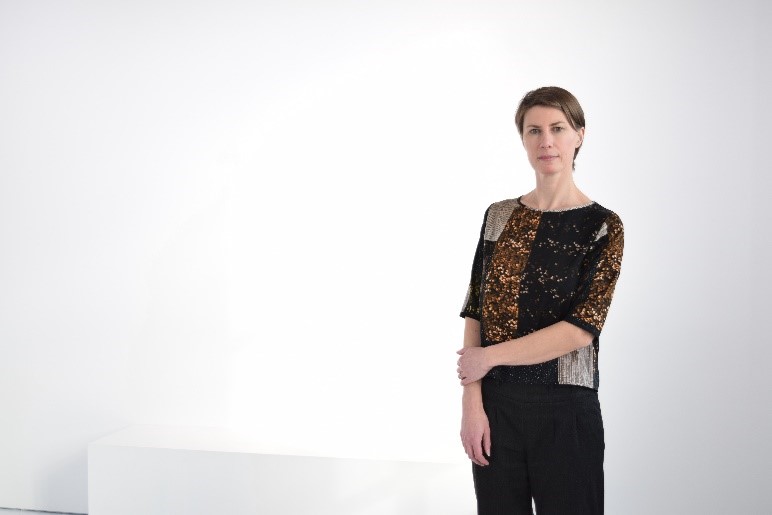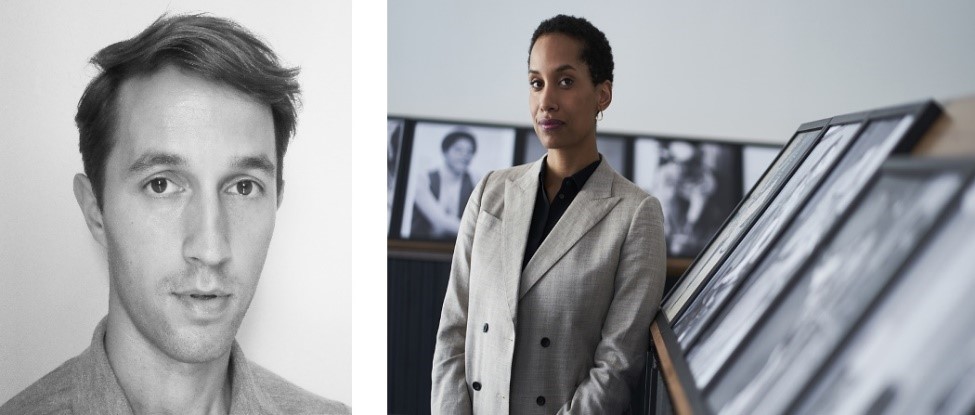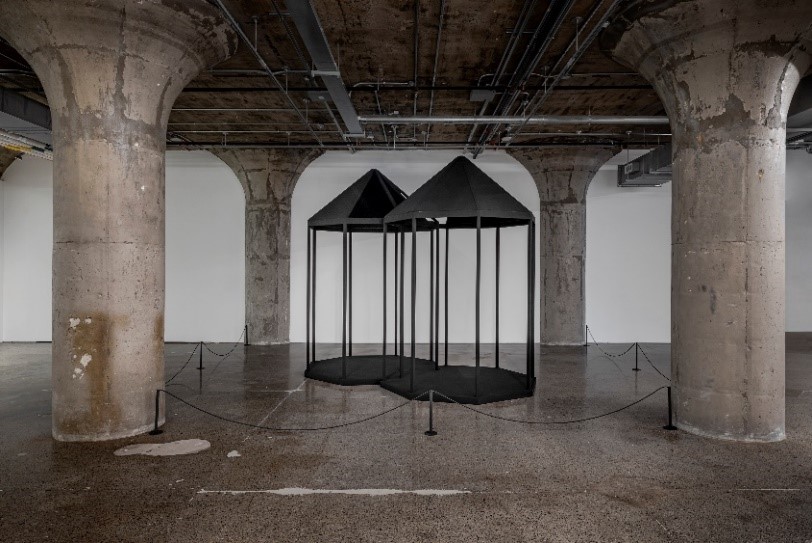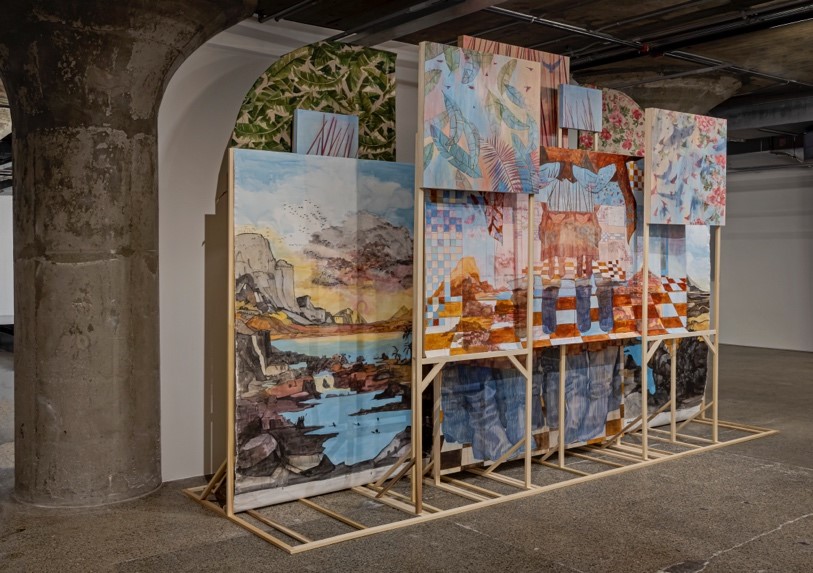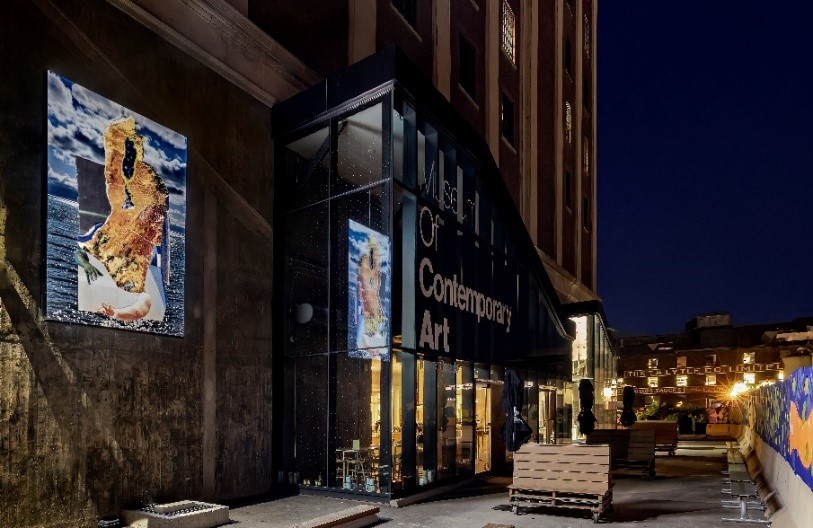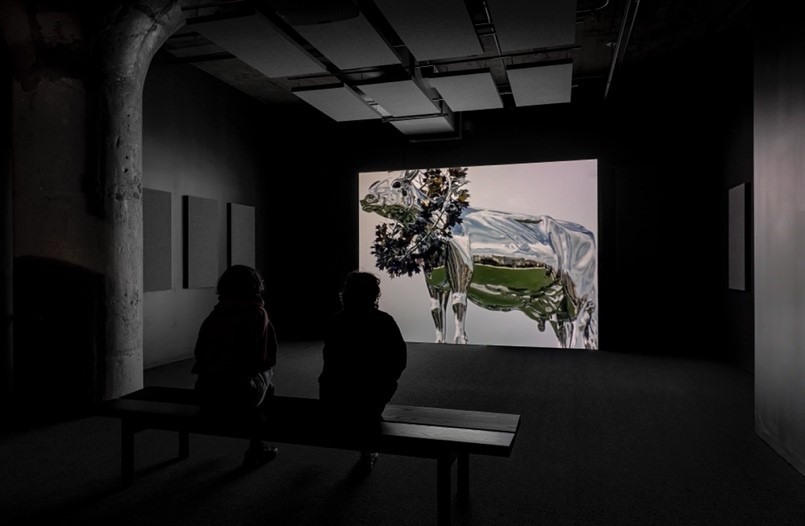MOCA artistic director and curator of GTA21 November Paynter. Photo by Worker Bee Supply
Interview with MOCA artistic director November Paynter, MOCA (NP) curator of Greater Toronto Art 2021 – MOCA (GTA21) by Phil Anderson (PA)
PA: Congratulations on putting together this grand art exhibition of local Toronto artists. I am sure that organizing this ambitious project during a pandemic has had its challenges. What was the process of the selection of artists like?
NP: Thank you. The curatorial team started meeting with artists and doing studio visits virtually in the summer of 2020. There was also a brief period in the fall when we could meet with a few artists in person. In each instance at least two of the curators aimed to be present and if we were excited about the potential to work together the third curator would then book a time to meet the artist as well. We were interested in understanding what the artists were working on at that moment, or what they were thinking about producing. We asked everyone ‘what feels urgent to you today’ and also ‘how their connection to Toronto and the GTA has informed their work’. The selection was quite intuitive; often there was a clear sense of urgency around an idea that we were excited to pursue together.
The other curators: MOCA adjunct curator Rui Mateus Amaral. Photo by Gun Roze (left) & guest curator of GTA21 Daisy Desrosiers, Director, Gund Gallery. Photo by Gabe Souza (right)
PA: As I understand it, 21 of the most exciting artists and art collectives working in relation to the city today were selected. Following their selection, did the artists submit proposals for inclusion in the exhibition?
NP: Most of the works developed organically from an initial idea as we spent months talking together – the artists and the curators. Some of the artworks were projects that the artists had started developing during lockdown that they then built further upon. Other works started with a discussion around an existing piece that then inspired a new direction responsive to the MOCA space. So, no one really submitted a proposal per se, really the process was one of discussion and collaboration.
Native Art Department International, Double Gazebo (MOCA), 2021, painted steel and wood. Courtesy the artists. Photo Toni Hafkenscheid (installation view MOCA Toronto, 2021). On the third floor, theme: Mutation
PA: It must have been difficult at times working with together as three curators. How did that process work on the selection of artists?
NP: We worked together really well and would always connect when there was something to resolve or think through.
PA: There are over 25 artists involved (counting those in collectives) ranging in age from 20 to 40 and with a diverse mix of cultures and backgrounds. That in itself paints a picture of the GTA. How important a role does that play in this exhibition?
NP: There are 26 artists in total, as well as the identity and publication designers, the editor, the many fabricators that helped with certain projects, the prep team and the MOCA team etc. You can imagine the exhibition as a holistic program driven and supported by many relationships, nearly all of which pivot around living and working in the GTA. In terms of the artists and art works, the exhibition expresses, or gives a sense, of the urgencies and contemporary condition of a specific moment in time in relation to a specific place. But it also shows how internationally connected and relative a local condition is. All in all, the exhibition is both rooted in the local, but is also expansive in its reach and references.
Pamela Phatsimo Sunstrum, Dynasty, 2021, pencil, acrylic and oil on wood, linen and canvas. Courtesy Goodman Gallery Johannesburg, Cape Town and London. Photo Toni Hafkenscheid (installation view MOCA Toronto, 2021). On the second floor, theme: Inheritance
PA: The exhibition spans three floors of MOCA. How difficult was it to determine which pieces went on each floor?
NP: As we started to understand better what each artist was working on for the exhibition, we began to build out the rhythm and structure of each floor. At the same time, we were doing interviews with the artists for the accompanying publication and these conversations helped inform more of a structure for both the book and the exhibition.
PA: There are three thematic groupings Ambivalence, Inheritance and Mutation – each having their own floor. Were artists selected for these groupings from the beginning?
NP: While there was never an overarching theme for the exhibition as a whole, we developed these three sub structures to help articulate common threads of interest and research between works. The floors of the museum also helped define these groupings, especially in the case of Ambivalence – wherein the ground floor of the museum is a composite of different functions and artworks installed here have to be considered in relation to a condition that is more informal.
Aaron Jones, Conscious Energy on the Sea, 2021, collage, light box. Courtesy Zalucky Contemporary, Toronto. Photo Toni Hafkenscheid (installation view MOCA Toronto, 2021). On the first floor, theme: Ambivalence
PA: There are several public artworks displayed on the grounds of MOCA. Can you tell us more about these works and their selection?
NP: One of the artists we invited to participate in GTA21, Ghazaleh Avaramani, had been looking at the MOCA building for years with an idea in mind. The idea was refined to become Mashrabiya, a sculptural installation that hangs on the facade of the building and was produced in partnership with ArtworxTO. Mashrabiya invites us to question the public accessibility of museums like MOCA through modes of open and obscured visibility. Offering a play on Islamic window screens, which permit views from inside out but not from outside in, this piece stands as an observation deck and a confessional; some visitors become observers, some are observed, but they cannot assume both roles at once.
Ghazaleh Avarzamani, Mashrabiya, 2021, painted steel. Courtesy Galerie Nicolas Robert, Montreal and Toronto. Avarzamani’s projects are part of ArtworxTO: Toronto’s Year of Public Art 2021 – 2022. Photo Toni Hafkenscheid (installation view MOCA Toronto, 2021).
We also worked with the National Film Board on a production with the artists Parastoo Anoushahpour, Faraz Anoushahpour and Ryan Ferko. The result is a digital project, but we approached our discussions around this production as a public art work commission, given it is online and accessible to anyone with wifi and a computer. You can see the final work ‘Charity’ here: https://www.nfb.ca/interactive/charity.
The collective of Parastoo Anoushahpour, Faraz Anoushahpour and Ryan Ferko, Surface Rites, 2021. Single-channel video, 16mm. Courtesy the artists. Photo Toni Hafkenscheid (installation view MOCA Toronto, 2021).
PA: The press release mentions some responsive digital components. What might the public expect to see? Are they interactive?
NP: In addition to the collaboration with the NFB we also commissioned a special web platform for GTA21. Designed by Andy Bako and Niko McGlashan, the platform shares a page of information on every artist in the exhibition. We also worked with them to create a GTA360 virtual environment that hosts digital commissions by a number of the artists. https://moca.ca/gta2021-gta360/
Then there are the digital extensions of Common Accounts’ work ‘Parade of All the Feels’ which offer Museum visitors the opportunity to launch Instagram filters via a series of QR codes. Finally, we will gradually share videos of the artists talking about their works, along with other online materials, throughout the exhibition run via the website.
Image of the digital GTA360 platform designed by Andy Bako and Niko McGlashan
PA: Looking forward, there are plans for GTA 2024 with new curators. Can you elaborate on the importance of engaging young Toronto artists for future exhibitions and the role of MOCA in doing so?
NP: MOCA is committed to supporting the local art community of Toronto by working closely with artists to produce new work and giving them space to develop their practice. The discussions that we shared with artists during this exhibition-making process made it clear that there is more to be done and we felt it important to state that it is our intent to work in this way again and hence committed to a triennial programme that evolves from this year’s exhibition. It will be incredibly interesting to see how a fresh ‘reading’ of the city in three years continues this conversation.
*Exhibition information: Greater Toronto Art 2021 / MOCA Toronto’s Inaugural Triennial Survey Exhibition, September 29, 2021 – January 9, 2022, MOCA, 158 Sterling Rd. Toronto. Museum hours: Wed, Thu, Sat and Sun 11 am – 6pm, Fri 11 am – 5 pm.

